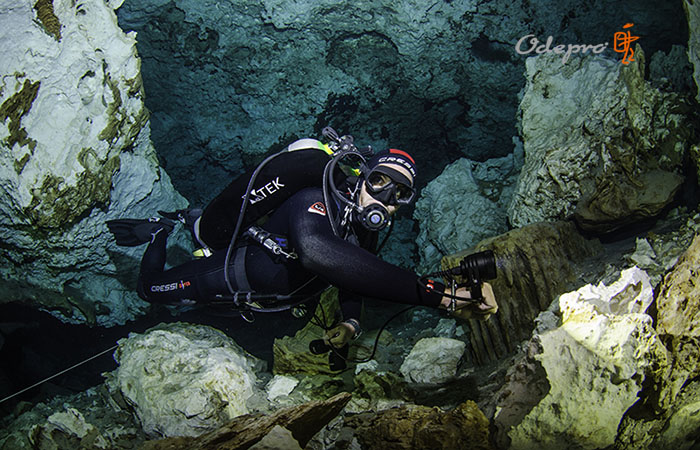Few things are much more shocking to the body than plunging into the frigid water. Our sophisticated human-machine knows instantly that it’s not where it’s supposed to be and reacts accordingly. Automatically, arteries tights, blood presses and heart rate increases and lungs gasp for air. In as little as five minutes, hyperventilation can occur, while extremities, including arms and legs, begin to lose feeling and the ability to move. As hypothermia sets in, the tongue swells and thoughts become cloudy as the body begins to lose its battle to focus blood flow to vital organs. A loss of consciousness follows, and it’s not hard to imagine how the story ends
So why do divers risk this slow and potential deadly torture? Because cold water breeds a wild variety of amazing marine life, along with some of the unique underwater environment on the planet. From the beautiful pastel anemones, hooded nudibranchs and giant Pacific octopuses of British Columbia to the towering kelp forests and playful pinnipeds of California, the otherworldly tectonic crack of Iceland, the dreamy leafy sea dragons of South Australia and the menacing leopard seals and comical penguins of Antarctica, bucket-list adventures abound in water that flirts with freezing. Add to the plus column natural preservation of aging shipwrecks at such destinations as the United Kingdom’s Scapa Flow, northern Europe’s Baltic Sea, Canada’s Nova Scotia coast and America’s Great Lakes, and you have ample reason to brave these icy waters
Thankfully, technology and training have advanced throughout the evolution of diving to make submersion in hostile environments possible — and even safe. Durable drysuits made from tough materials, silicone sealing systems that really keep the water out, advanced life-support systems designed to resist freezing and heated undergarments that can keep body- core temperatures at near summertime levels can make cold-water diving seem like a dip in the Caribbean. (Almost.) No divers know this better than the hardy souls who thrive in the Great Lakes, where water temps average in the 50s. Dough Bell of Scuba North in Traverse City, Michigan, has been exploring the shipwrecks of Lake Superior and its deep blue sisters since 1979.
“I’ve been able to dive some of the most prominent shipwrecks around the globe,” says Bell, including Andrea Doria, USS Monitor and SS President Coolidge, along with the World War II wrecks of Bikini Atoll, Chuuk Lagoon, and Scapa Flow. “But I’m always drawn back to the Great Lakes. They have everything from schooners dating to the 1700s to modern-day freighters. And new discoveries are made every year.”
A professional since 2010, Bell teaches trimix, cave and technical courses. Says the Michigan native, “There are many different definitions for ‘cold-water diving,’ but practically speaking, I consider it anything below 60 degrees.” During his long underwater experience at these trying temperatures, he’s learned some lessons.
“When you spend 3 1?2 hours in cold water on one of these wrecks, you really have to prepare well,” says Bell.
PREPARE FOR THE CHALLENGE
Bell’s first step in a successful cold-water dive: using specifically designed equipment that has been properly maintained and regularly serviced. “It is essential to use regulators that are designed for cold-water use,” he says. “Free-flow can be an issue if you do not have the properly serviced equipment.”
Hoods and gloves are standard fare. “If you are not used to them, it’s wise to start with a couple of easy shore dives,” Bell explains. “In recent years electrically heated undergarments have become standard equipment and have made a huge difference, comfort wise.”
CRAFT YOUR PLAN ACCORDINGLY
A cold-water dive plan should be taken into account variables not present in warm-water diving, says Bell.
“It is not uncommon for surface air-consumption rates to increase in cold water, oftentimes due to some level of anxiety,” he explains. “So it’s good to be aware of this when planning your dive.”Learning how to handle a free-flowing regulator and being comfortable with air-sharing drills is paramount. Practicing mask clearing and removal in cold water is a good idea, Bell says, because it’s quite a bit different when that cold water hits your face. “Understand signs of hypothermia and what to do,” he recommends. “Also, it is important to be completely comfortable calling the dive when you feel yourself starting to get too cold.”
ACCLIMATE TO THE COLD SLOWLY
Instead of giant-striding off the platform into 50-degree water, Bell advises proceeding gradually to allow your system to acclimate. “Slowly allow your body to be introduced to the water,” he says. “Shore dives are great for this and allow your breathing rate to stabilize prior to descending.”By avoiding the instant shock of immersion, the body can more safely adjust. “Go slow and allow yourself to get comfortable at each step. Then incrementally increase your depth.”
FINISH STRONG
When your dive is done, raising the body’s core temperature is a primary goal. “First, put on some warm clothes,” says Bell. “Hot drinks are great as well.” And remember to glean tips from the other divers in your group. “Having an experienced cold- water diver is a great benefit,” Bell says. “Don’t be afraid of the cold water. It’s simply a matter of using the right equipment, building experience and gaining confidence. It will open the door to some of the best diving in the world.”

Copyright 2014-2018 www.odepro.com
Shenzhen Odepro Technology Co., LTD All Rights Reserved
Address: Building 6, Rundongsheng Industrial Park, Gushu, Xixiang, Baoan, Shenzhen, China (518126)
TEL :(86)755-36538983
Email:odepro@odepro.com
Built By OdePro China
Odepro outdoor technical support

Odepro